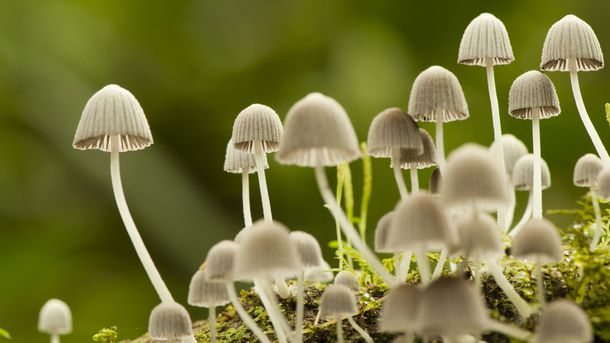In this article we will discuss about the classification of fungi by Ainsworth G. C
Ainsworth G. C. (1966, 71, 73) proposed a more natural system of classification of fungi. This classification is based on morphology, especially of reproductive structure. He includes fungi along with slime molds under the kingdom Mycota.
Based on the presence or absence of Plasmodium and pseudoplasmodium; the kingdom Mycota is further divided into two divisions:
Myxomycota i.e., slime molds and Eumycota or true fungi. Divisions are subsequently divided into subdivision, class, subclass, order, family and then to genus. According to his classification, division ends in mycota, subdivision in mycotina, class in mycetes, subclass in mycetidae order in ales and family in aceae.
A schematic outline of Ainsworth’s (1973) classification is given:
Kingdom: Mycota
Important features:
i. Free-living, parasitic or mutualistic symbionts, devoid of chlorophyll.
ii. Cell wall composition is very variable, majority contain chitin and glucan.
iii. Reserve food materials are oil, mannitol and glycogen.
iv. Except some unicellular members, majority are filamentous.
A. Division. Myxomycota:
Wall-less organisms possess either a Plasmodium (a mass of naked multinucleate protoplasm having amoeboid movement) or a pseudoplasmodium (an aggregation of separate amoeboid cells). Both are of slimy consistency, hence slime molds.
1. Class. Acrasiomycetes (cellular slime molds)
2. Class. Hydromyxomycetes (net slime molds)
3. Class. Myxomycetes (true slime molds)
4. Class. Plasmodiophoromycetes (endo- parasitic slime molds).
B. Division Eumycota (True fungi, all with walls):
a. Subdivision Mastigomycotina (motile cells – zoospores present, perfect state spore-oospore).
1. Class. Chitridiomycetes (unicellular, zoospore with single whiplash flagellum).
2. Class. Hyphochytridiomycetes (unicellular, zoospore with single tinsel flagellum).
3. Class. Oomycetes (aseptate mycelium, zoospores with two flagella).
b. Subdivision. Zygomycotina (mycelium aseptate, perfect state spore-zygospore).
1. Class. Zygomycetes (mycelium immersed in the host tissue).
2. Class. Trichomycetes (mycelium not immersed in the host tissue).
c. Subdivision. Ascomycotina (yeasts or septate mycelium, perfect state spore- ascospores formed in ascus, usually within ascocarp).
1. Class. Hemiascomycetes (no ascocarp, asci naked).
2. Class. Loculoascomycetes (fruit body an ascostroma, asci bitunicate i.e., 2-walled).
3. Class. Plectomycetes (fruit body cleistothecium, asci unitunicate i.e., 1-walled).
4. Class. Laboulbeniomycetes (fruit body perithecium, asci unitunicate, exoparasite of arthopods).
5. Class. Pyrenomycetes (fruit body perithecium, asci unitunicate, not parasitic on arthopods.
6. Class. Discomycetes (fruit body apothecium, asci unitunicate).
d. Subdivision. Basidiomycotina (yeast or septate mycelium, perfect state spore – basidiospore formed on a basidium).
1. Class. Teliomycetes. Basidiocarp lacking, teliospores grouped in sori or scattered within the host tissue, parasitic on vascular plant.
2. Class. Hymenomycetes. Basidio- carp present. Hymenium is completely or partly exposed at maturity. Basidiospore ballistospores.
3. Class. Casteromycetes. Basidiocarp present. Hymenium enclosed in basidiocarp. Basidiospore not ballistospores.
(e) Subdivision. Deuteromycotina or Fungi imperfecti. Yeast or septate mycelium. Perfect state unknown.
1. Class. Blastomycetes. Budding (Yeast or Yeast like) cells with or without pseudomycelium. True mycelium lacking or not well-developed.
2. Class. Hyphomycetes. Mycelia sterile or bearing asexual spore directly or on conidiophore, in various aggregation.
3. Class. Coelomycetes. Mycelial; asexual spore formed in pycnidium or acervulus.
Schematic representation of the outline with figure, the classification of G.C. Ainsworth (1973) is given:
The classification of Ainsworth (1973) has been followed in this book. Later, Webster (1980), Deacon (1980) and Hudson (1986) also proposed their classifications. Among all the above classifications, Ainsworth’s classification has been accepted by many mycologists, with some comments.
Say for example, the Mastigo- mycotina is a composite grouping covering all fungi that form motile flagellated zoospores. Among others, unrelated classes like Chitridio- mycetes and Oomycetes were included in the same group. Oomycetes has indeed quite a different evolutionary origin to that of most other fungi.
Fungi: Classification of Fungi by Ainsworth G. C (With Diagram) | Mycology
![Fungi: Classification of Fungi by Ainsworth G. C (With Diagram) | Mycology]() Reviewed by Rajkumar
on
October 31, 2017
Rating:
Reviewed by Rajkumar
on
October 31, 2017
Rating:


No comments: